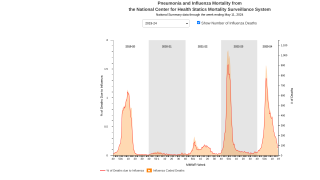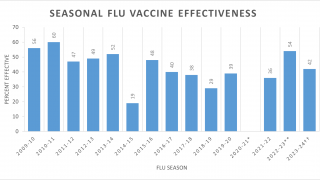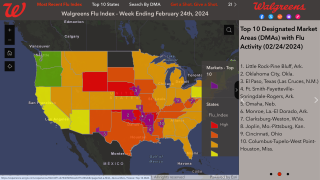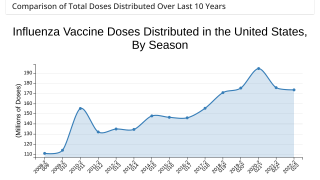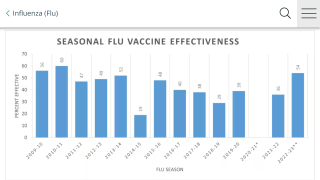Influenza A Is Dominating in the Northern Hemisphere

Seasonal influenza A viruses continued to account for the majority of detections around the globe, though the proportion of influenza B viruses increased in recent weeks, reported the World Health Organization (WHO).
On October 29, 2019, the WHO found in the temperate zone of the Northern Hemisphere, influenza activity remained at interseasonal levels in most countries. Of the 5,005 samples evaluated during early October, influenza A made up 60.5 percent.
Of the sub-typed influenza A viruses, 35.6 percent were influenza A(H1N1)pdm09 and 64.4 percent were influenza A(H3N2). Of the characterized B viruses, 14.1 percent belonged to the B-Yamagata lineage and 85.9 percent to the B-Victoria lineage.
On October 26, 2019, the Centers for Disease Control and Prevention (CDC) reported the seasonal influenza activity in the USA increased slightly, but remains low, when compared to previous years.
The flu season in the USA typically begins in October with a peak number of cases reported in February. And during the early part of 2019, the flu season continued into May.
From a regional perspective in the Northern Hemisphere:
- In Western Asia, influenza activity continued to increase across the countries of the Arabian Peninsula, with influenza A(H3N2) viruses predominating in Qatar and all seasonal influenza subtypes co-circulating in Kuwait and Oman.
Countries in the tropical zone:
- In the Caribbean countries, influenza activity remained low overall.
- In Central American countries, influenza activity continued to increase in El Salvador and Nicaragua, with influenza A(H1N1)pdm09 and A(H3N2) predominately detected, respectively.
- In the tropical countries of South America, influenza activity was low in general among those countries reporting data for this period.
Tropical Africa:
- In Western Africa, influenza activity remained elevated in most reporting countries.
- Increased influenza virus detections continued to be reported in Côte d’Ivoire [influenza A(H3N2) and B/Victoria lineage], Guinea (influenza B/Victoria lineage), Mauritania (all seasonal influenza subtypes), and Niger [influenza A(H3N2)]. Influenza-like illness (ILI) activity appeared to decrease in Senegal.
- Influenza activity remained elevated in Togo with an increased number of severe acute respiratory infection (SARI) cases and detections of influenza A(H3N2) and B viruses.
- In Middle Africa, influenza detections of predominantly influenza B/Victoria lineage and influenza A(H1N1)pdm09 were reported in Cameroon and South Sudan, respectively.
- In Eastern Africa, influenza detections were low across reporting countries. A slight increase of influenza A(H1N1)pdm09 virus detections were reported in Kenya.
- In the French island, La Réunion ILI consultations remained elevated with influenza A(H1N1)pdm09 virus most frequently detected.
Tropical Asia:
- In Southern Asia, influenza detections were low across reporting countries.
- In Bhutan, influenza percent positivity continued to decrease and returned below the national baseline. Detections of influenza A(H3N2) and B/Victoria lineage viruses were low.
- In Nepal, influenza detections appeared to decrease, though ILI and SARI were reported at high levels.
- In Southeast Asia, influenza activity was reported in some countries. In recent weeks, influenza activity increased in Lao PDR and the Philippines, with detections of predominately influenza B/Victoria-lineage in the former and influenza A(H3N2) viruses in the latter.
- In Indonesia, ILI levels increased in recent weeks but there was no reporting for influenza virus detections.
Countries in the temperate zone of the Southern Hemisphere:
- In the temperate zones of the southern hemisphere, influenza activity continued to decrease overall.
- In Oceania, influenza activity was low. In Australia, ILI and weekly notifications of laboratory-confirmed influenza are further decreasing but not yet at inter-seasonal levels.
- In South Africa, influenza and ILI activity remained below the seasonal threshold.
- In temperate South America, influenza activity was low in most countries. In Chile, influenza activity of predominately B viruses continued to be reported, though decreased.
Influenza Vaccine news
- Expecting Moms Need Both Tdap and Flu Vaccinations
- Spontaneous Miscarriage Not Associated With Flu Shot
- Flu Vaccine Effectiveness Influenced By Oral Antibiotics
- Flu Shots & Antivirals Recommended For Children
Everyone 6 months of age and older should get a flu vaccine every season, with rare exceptions, says the CDC.
Different flu vaccines are approved for use in different groups of people. There are flu shots approved for use in children as young as 6 months of age and flu shots approved for use in adults 65 years and older.
Additionally, the CDC continues to recommend that pregnant women get an influenza vaccine during any trimester of their pregnancy because influenza poses a danger to pregnant women and a flu shot can prevent influenza in pregnant women.
As always, vaccination decisions should be part of an ongoing discussion between a provider and patient.
The nasal spray flu vaccine is approved for use in non-pregnant individuals, 2 years through 49 years of age. But, people with some certain medical conditions should not receive the nasal spray flu vaccine.
The Global Influenza Programme monitors influenza activity worldwide and publishes an update every 2-weeks. The updates are based on available epidemiological and virological data sources, including FluNet (reported by the WHO Global Influenza Surveillance and Response System) FluID (epidemiological data reported by national focal points) and influenza reports from WHO Regional Offices and the Member States.
The data completeness can vary among updates due to the availability and quality of data available at the time when the update is developed.
Influenza news published by Precision Vaccinations
Our Trust Standards: Medical Advisory Committee
















